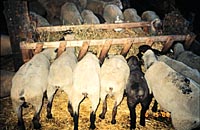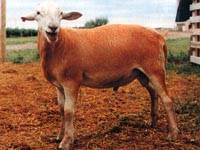Sheep are raised for a variety of reasons throughout the world. They are commonly raised for meat, wool and in some regions, for milking. Sheep are noted for their ability to efficiently use a variety of pasture types which other grazing animals such as cattle have used with limited success. These properties make sheep a very productive animal which has established itself as one of the more popular types of livestock in the world.

The goal of the sheep producer is often limited by the local economy, and the breed of sheep raised. In Canada, sheep production is aimed primarily at producing meat, and secondly, wool. This is because the most common breed of sheep in Canada is the suffolk. These animals produce a suitable carcass, but have a lower quality fleece when compared to that of merino breed which populates Australia and New Zealand. The lower prices paid for suffolk wool makes meat production the most popular choice in Canada.
There are 4 main classes of sheep production in Canada.
- Purebred Operations
- range in size from 10 to 500 breeding ewes
- serve as a source of genetics (foundation breeding stock) to improve the commercial sheep industry
- supply replacement animals to breeding flocks
A purebred sheep should show the distinct characteristics of the breed, and be eligible for registration in the breed association.
- Farm Flocks
- the most common type of production in Saskatchewan
- raise sheep for meat and wool
- can make use of pasture or confinement management programs
- breed of sheep is very important
- very labor intensive operations
- Feeder Operations
- lambs are purchased at 22 - 28 kilograms, placed into a drylot and fed hay, grain and supplements until market weight (40 - 55 kilograms). At this weight, they are marketed as butcher lambs.
- feed cost is the largest concern
- Dairy Sheep
- not a major component of the Saskatchewan sheep industry
- has been successful in Ontario and British Columbia
- supplies an easily digestible type of milk, but mainly used for cheese production

The majority of Saskatchewan sheep producers raise market lambs, which are later fed to produce meat for us, the consumer. This katahdin sheep is one of the newer breeds in Saskatchewan and raised for its high quality carcass. Usually, a crossbred ewe is bred to a purebred ram. The offspring are marketed as commercial lambs. Production of selected crossbred replacement ewes is a growing part of the industry. Wool production has not been a major part of the industry, however, some producers have focused management and breeding towards this market as a market lamb production. Specialty flocks produce wool for hand spinners and weavers, usually coloured sheep which are crosses of Karakul, Rambouillet and Colombia. Other specialty breeds such as Shetland and Lincoln are bred for this market, but there are very few of these types in the province.
|
